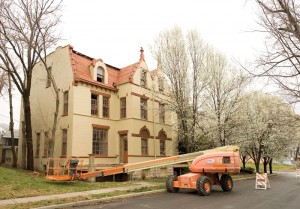By LESLIE COLLINS
Northeast News
May 8, 2013
It was a building in Pendleton Heights that inspired City Council member Scott Wagner to propose amending the city’s historic designation ordinance.
Built in 1888, the duplex known as “The Chateau” was a prime example of the Chateauesque-style of architecture. It was a rarity in Kansas City and was listed on the Kansas City Register of Historic Places. Its brick exterior featured classically-inspired columns, terracotta lintels with low-relief carving and pedimented dormers, among other elements.

“It was just beautiful,” said Kent Dicus, president of the Northeast Kansas City Historical Society and former president of the Pendleton Heights Neighborhood Association.
In 2009, however, the city listed the building on the city’s dangerous buildings list and demolished the building in a matter of days.
Not wanting to lose other pieces of Kansas City history, Wagner met with the Kansas City Historic Preservation Commission and the Historic Kansas City Foundation last summer to find out if something could be done. Together, they created an ordinance that suspends a demolition permit if an application is filed to designate a building as historic. City Council members approved the ordinance amendment during their April 25 meeting.
Wagner said he didn’t have a building in mind to save when creating the ordinance, but wanted to improve the overall historic preservation process and potentially save future historic structures from demolition.
“What the demolition delay ordinance would allow you to do is to say before you knock it down, let’s see if there’s any real value to that building – culturally, historically – and if there is, there’s an opportunity to save it,” Wagner said.
Over the years, the wrecking ball has erased a significant amount of Kansas City history.
In 2009, SolutionsBank foreclosed on the 6315 Ward Parkway 16-room mansion, which once belonged to H&R Block co-founder Richard Bloch, and stated the last owners who gutted the house for rehab left the home in such a state that the mansion was worth more demolished.
Before the Kansas City Landmarks Commission could meet to decide whether or not to place the mansion on the Kansas City Register of Historic Places, the bank began the demolition process. Just three years before the demolition, the mansion earned the Symphony Designers’ Showhouse of the Year.
“When that was torn down, you realized that no building was sacred in Kansas City, that nothing could protect a house,” Dicus said. “If the Bloch mansion could be demolished, then really nothing was sacred.”
Three weeks ago, before the new ordinance passed, Shirley Helzberg opted to demolish the Orion Pictures building, 118 W. 17th St., which was part of Kansas City’s iconic Film Row, to make way for a three-story parking garage. Hollywood used Kansas City’s Film Row from the 1920s to 1970s as a central distribution center for films. The Orion building was not listed on the local historic registry.
“People were trying to save it and Mrs. Helzberg said, ‘No, it’s gone,’ and money talks,” said David Remley, Historic Northeast resident and photographer who specializes in architecture. “All of the buildings were intact until three weeks ago. I felt sad because again the city has no heart for preservation on an ongoing basis. We will try to save the big things like Union Station, Folly Theater and the President Hotel, but the small things in neighborhoods, like that (Orion) building in the Crossroads, we don’t pay much attention.”
If the new ordinance had been in effect, the building possibly could have been saved.
The ordinance allows an owner, a city council member, a member of the Historic Preservation Commission, a neighborhood association and other historic preservation organizations to file an application to designate a building as historic, and the application automatically suspends the demolition permit.
Once the application is filed, the Historic Preservation Commission must hold a public meeting on the proposed nomination within 45 days of the application and must make a decision within 90 days. The demolition permit can be suspended up to 6 months during the process. A demolition permit cannot be suspended if the building is listed on the city’s dangerous buildings list due to safety hazards, or if the director of city planning and development determines the property doesn’t meet the minimum requirements for historic designation.
Demise of The Chateau
“We hadn’t been given a notice at all that the building was dangerous,” Dicus said of The Chateau.
Dicus happened to see the notice while taking a stroll through the neighborhood on a Friday. By Monday, crews were ready to demolish the building, but inclement weather delayed the process. The city had placed the building on the emergency demolition list since a portion of the roof had caved in. Dicus toured the building and said while the owner hadn’t restored the building, the interior was intact along with the original woodwork.
“It wasn’t 100 percent sealed or watertight, but it wasn’t bad,” Dicus said.
Pendleton Heights didn’t want to say good-bye to the historic building and pleaded with city officials to delay the demolition.
“I remember saying, ‘Just give us 48 hours. We’ll get someone to take it and fix it,’” Dicus said. “But, they were very insensitive about that approach.”
The neighborhood contacted media and anyone they could think of to rally against the demolition. They even found an investor ready to repair the roof, but by that time the damage had been done. Wrecking crews had already compromised the structure’s integrity. Where a rare piece of architecture once stood is now a vacant lot.
“It was really like a punch in the stomach because we had made so many strides from a preservation standpoint in years before,” Dicus said. “We had saved buildings. The neighborhood was on a big upswing… This (demolition) really came out of the blue.
“If we don’t have our preservation and we don’t have our architecture, all we are is another old neighborhood in an urban community.”
In the past, the city has made exceptions to its dangerous buildings list. When the city ordered emergency demolition of the Cosby Hotel built in 1881 due to a weak brick wall, the efforts of the Downtown Council and a Facebook campaign “Save the Cosby” convinced the city to halt the demolition. To prevent the west wall from falling, the city paid $4,000 for repairs and then billed the owner. Sunflower Development Group purchased the building and is currently renovating the site. On its webpage, the Sunflower Development Group called the Cosby Hotel a “huge time-capsule in the heart of downtown” and said they have an opportunity to transform an eyesore into a landmark property.
Both Dicus and Remley said the new ordinance is a step in the right direction for historical preservation. However, Remley said more needs to be done.
“The dangerous buildings (department) in my opinion needs to be reigned in,” Remley said. “I would like to see future constraints put on dangerous buildings in regard to historic structures and the demolition thereof.”
Remley suggested the city should seek a second opinion in evaluating the current condition of a historical building. He cited the Cosby Hotel, which the city originally thought was unsalvageable.
European countries treasure their history and preserve their buildings, using them as tourist attractions and for educational purposes, Remley said.
“It’s one thing to read about The Chateau in a book; it’s another thing to walk over and look at it,” Remley said. “There are guided tours of school children along Gladstone Boulevard all the time, looking at the old houses, noting the style of architecture, the age of the building. If you don’t preserve those things, you don’t have them to look at or have them as a reference. History is important and that’s a part of history.”


















